David Cohen (President, IAB) joins Luke Stillman (SVP, Digital Intelligence) to discuss the new and the next for programmatic advertising.
Continue reading “IAB There: Programmatic Advertising in 2020 and Beyond”
David Cohen (President, IAB) joins Luke Stillman (SVP, Digital Intelligence) to discuss the new and the next for programmatic advertising.
Continue reading “IAB There: Programmatic Advertising in 2020 and Beyond”
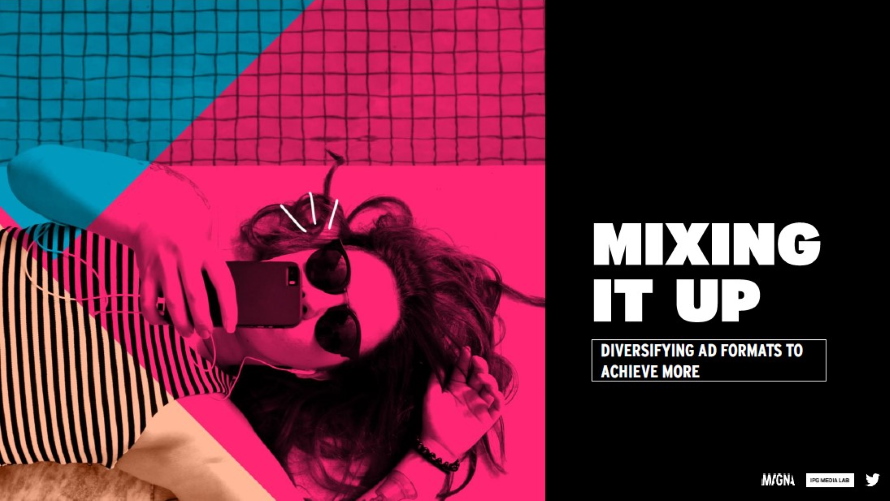
Should advertisers with fixed budgets spend more money on a single ad format, or should they spread their budgets across multiple formats? Twitter teamed up with Magna and IPG Media Lab on a study to answer that very question.
The social network and the two IPG Mediabrands units said the results of “Mixing It Up: Diversifying Ad Formats to Achieve More” demonstrated that the use of multiple formats in digital advertising can help brands better tell their stories and boost awareness, brand favorability, research intent and purchase intent.
Research was done in two parts: An eye-tracking analysis with 69 Twitter users who visited Magna’s lab in San Francisco and donned eye-tracking glasses, and an ad-effectiveness analysis with some 4,000 Twitter users participating on mobile devices across three ad types: preroll (dubbed Amplify on Twitter), traditional promoted video and First View (a one-day takeover of the standalone video ad atop the feed).
The test was conducted across six industry verticals and 136 different ad scenarios, and key findings included:
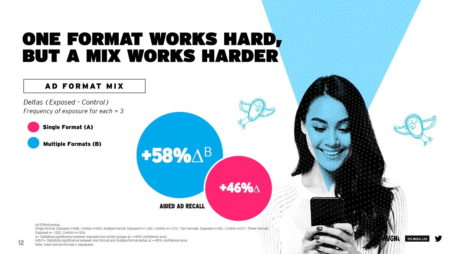
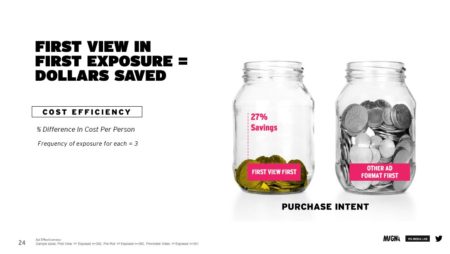
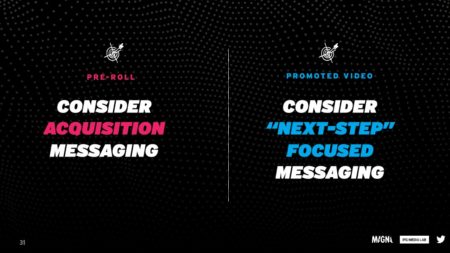
Twitter head of global business partners Stephanie Prager said in a statement, “When you’re building a campaign, you’re trying to tell the best, most impactful and most accessible story possible. Our research validates that at its best, storytelling isn’t just about the message: It’s also about the method. We hope this encourages advertisers to continue exploring and experimenting with the different surfaces and formats for their messages that live within digital platforms like Twitter.”
Magna senior vice president of intelligence solutions Kara Manatt added, “For a long time, many brands thought it made sense to put a majority of their budget into an ad format that worked for them, but our study’s findings are a major differentiator because it indicates that a mix works better at driving awareness, purchase intent and brand favorability. Creating this sort of variation in ad experiences doesn’t necessarily require creating a whole host of new assets. In our study, the same exact ad led to better results when presented differently.”
NEW YORK – July 9, 2020 – Now more than ever advertising budgets are fixed, leaving the bulk of advertisers questioning whether to spend more on a single ad format or spread budget across multiple formats. In a new study by Twitter, MAGNA and IPG Media Lab, “Mixing It Up: Diversifying Ad Formats to Achieve More,” results demonstrate that diversifying ad formats in digital advertising can help marketers better convey their story and create bigger impact on awareness, brand favorability, as well as research and purchase intent. In addition, being thoughtful about the order in which ad formats are delivered can further boost performance.
The main objective of the study was to find out if ad format synergy is real, and if so, explore how advertisers should leverage it to make budgets go further. Research was conducted in two parts: via eye-tracking to test eyes on screen and ad effectiveness to test impact on branding metrics across different ad formats and ad mixes. The ad effectiveness portion included around 4,000 Twitter users for participation on mobile devices across three ad types including Pre-roll (which is known as Amplify at Twitter), traditional Promoted Video, and First View. The test was conducted across six industry verticals and 136 different ad scenarios.
Additional key findings of the study include:
Stephanie Prager, Twitter’s Head of Global Business Partners, said, “When you’re building a campaign, you’re trying to tell the best, most impactful and most accessible story possible. Our research validates that at its best, storytelling isn’t just about the message; it’s also about the method. We hope this encourages advertisers to continue exploring and experimenting with the different surfaces and formats for their messages that live within digital platforms like Twitter.”
“For a long time, many brands thought it made sense to put a majority of their budget into an ad format that worked for them, but our study’s findings are a major differentiator because it indicates that a mix works better at driving awareness, purchase intent and brand favorability,” said Kara Manatt, SVP, Intelligence Solutions at MAGNA. “Creating this sort of variation in ad experiences doesn’t necessarily require creating a whole host of new assets. In our study, the same exact ad led to better results when presented differently.”
The full study can be found here.
About Twitter
Twitter, Inc. (NYSE: TWTR) is what’s happening in the world and what people are talking about right now. On Twitter, live comes to life as conversations unfold, showing you all sides of the story. From breaking news and entertainment to sports, politics and everyday interests, when things happen in the world, they happen first on Twitter. Twitter is available in more than 40 languages around the world. The service can be accessed at twitter.com, on a variety of mobile devices and via SMS. For more information, visit about.twitter.com or follow @twitter. For information on how to download the Twitter and Periscope apps, visit twitter.com/download and periscope.tv.
About MAGNA
MAGNA is the centralized IPG Mediabrands resource that provides strategic investment and media intelligence for agency teams and clients. We utilize our insights, forecasts and strategic relationships to provide clients with a competitive marketplace advantage.
MAGNA harnesses the aggregate power of all IPG media investments to develop go-to-market strategies, designing unique partnerships to drive maximum value for our clients. MAGNA has set the industry standard for more than 60 years by predicting the future of media value. We publish more than 40 annual reports on audience trends, media spend and market demand as well as ad effectiveness.
MAGNA infuses the organization with knowledge that empowers better decision-making. We are a team of experts across five key competencies who support IPG cross-functional teams through: Partnership, Enablement, Accountability and Connectivity. Follow us on Twitter @MAGNAGLOBAL.
About IPG Media Lab
Part of the Interpublic network, the IPG Media Lab identifies and researches innovations and trends that will change the media landscape and how brands engage with their audiences. Since 2006, the Lab has worked with our clients and with industry partners who can help them best adapt to disruptive change. Its expertise, resources and consulting services also help to inform the learnings, strategies and business outcomes of all Interpublic agencies. For more information, please visit www.ipglab.com or follow @ipglab.
# # #
Media Contact:
Zinnia Gill
IPG Mediabrands
Director, Global Corporate Communications
(646) 965-4271
NEW YORK–(BUSINESS WIRE)–IPG Mediabrands today released its 10 Media Responsibility Principles (MRP) as part of a larger effort to balance brand safety and brand responsibility in advertising. While “Brand Safety” protects the brand, “Brand Responsibility” protects the communities that a brand serves, weighing the societal impact of the content, the publishers and services, and the platforms being funded by advertising. IPG Mediabrands’ MRPs are a call to action for companies to hold themselves to higher standards more broadly when it relates to brand safety and brand responsibility matters, not just in media.
“If it is the purpose of a brand to serve the public, and advertising is the way to build brands, then brands need to ensure that the same media channels used for advertising to reach people do not result in or contribute to harm,” said Joshua Lowcock, Chief Digital Officer, UM and Global Brand Safety Officer, IPG Mediabrands. “Our Media Responsibility Principles will serve as an important check and balance in helping marketers and their agencies make better decisions on where to invest media and hold partners accountable.”
“We are advising our clients, as well as all advertisers and marketers industry-wide, to adapt these Media Responsibility Principles in alignment with their existing Corporate Social Responsibility principles,” said Daryl Lee, Global CEO, IPG Mediabrands. “This will move the industry in the right direction by establishing brand safety and brand responsibility as the common currency under which all media is transacted.”
IPG Mediabrands’ 10 Media Responsibility Principles:
1. PROMOTE RESPECT
Seek out media partners that foster balanced, constructive discourse and respectful civil commentary. Avoid and eliminate working with media partners or platforms that create hostile conversation environments. This includes holding partners accountable if individuals, content or programming consistently confronts an individual or group of individuals based on their religion, race or sexual orientation.
2. PROTECT PEOPLE
Prioritize partners that protect people from harm. This includes requiring partners to take active steps to prevent predatory behavior against an individual or group of individuals. Require partners to flag, limit or remove content that would mislead people as to their rights or how to access public services.
3. DIVERSE AND REPRESENTATIVE
Media partners need to demonstrate that they celebrate all forms of diversity, including all genders, multicultural backgrounds, ages, sexual orientations, people with disabilities, all socio-economic groups, and faiths. That when advertising is delivered, there is conscious effort made to ensure that the ads are delivered against an audience that is representative of the diversity in the population and non-discriminatory.
4. DATA COLLECTION AND USE
That media partners and advertisers collect and use data in ways that are ethical, accountable and fair. That data is collected and used in way that complies with all applicable regulations and industry codes. That rules exist so that data is not used in advertising in a way that would inadvertently or unintentionally discriminate against an individual or group of individuals or their ability to access employment, housing, or other products and services.
5. CHILDREN’S WELLBEING
Media partners and advertisers have a shared responsibility to ensure that both regulatory and industry codes are consistently applied for protecting the welfare of children. That partners are required to demonstrate that they have the appropriate controls in place to protect children and, as necessary, age gate the delivery of advertising where necessary.
6. NO HATE SPEECH
Brands should not fund hate speech or extremist content. Avoid advertising with media outlets that fuel hatred on the grounds of race, religion, nationality, migration status, sexuality, gender or gender identity, disability or any other group characteristic. This includes not advertising on content, services, or platforms where there is speech that attempts to dehumanize a person or group of people or that promotes or features content that would incite violence or discrimination.
7. NO MISINFORMATION / DISINFORMATION
That media investment will be directed to partners that ensure people receive quality, factual information that enables them to make well-informed decisions and not fund partners or content that spread misinformation. Advertising should not fund misinformation or disinformation. Platforms will fact check information published by high-profile and/or high reach accounts; ensure that factual information from reputable sources is published alongside false claims from said accounts; and put systems in place to stop amplification of false information. Priority areas include topics around healthcare and the environment.
8. ENFORCE POLICY
That any media partner consistently apply their own terms of use policy. That partners in a common category or vertical align on a common policy standard that outlines the expectations of those on the platforms, whether they be end-users, creators, or hosts, and that the policies be transparently enforced regardless of role, title, position, or office.
9. ADVERTISING TRANSPARENCY
That there be supply chain transparency so that advertisers know when and where they are advertising, whether this be a publisher, platform, program, or page. So that advertisers can make informed decisions that will enable compliance with these overarching principles.
10. ACCOUNTABILITY
That each party in the advertising supply chain, Advertisers, Agencies, and Publishers/Platforms will hold themselves individually accountable for adhering to these principles. That we collectively recognize that revenue from advertising is a privilege and not a right, and that there must be an open and honest dialogue with partners who fail to be accountable to these principles.
ABOUT IPG MEDIABRANDS:
IPG Mediabrands is the media and marketing solutions division of Interpublic Group (NYSE: IPG). IPG Mediabrands manages approximately $40 billion in marketing investment globally on behalf of its clients across its full-service agency networks UM and Initiative and through its award-winning specialty business units Reprise, MAGNA, Orion Holdings, Rapport, Healix and the IPG Media Lab. IPG Mediabrands clients include many of the world’s most recognizable and iconic brands from a broad portfolio of industry sectors including automotive, personal finance, consumer product goods (CPG), pharma, health and wellness, entertainment, financial services, energy, toys and gaming, direct to consumer and e-commerce, retail, hospitality, food and beverage, fashion and beauty. The company employs more than 12,000 diverse marketing communication professionals in more than 130 countries. For more information, please visit our website: www.ipgmediabrands.com and be sure to follow us on Twitter or Instagram.
PRESS:
Neena Koyen
SVP, Head of Global Corporate Communications
[email protected]
By SARA JERDE. Published by ADWEEK on 15 June 2020.
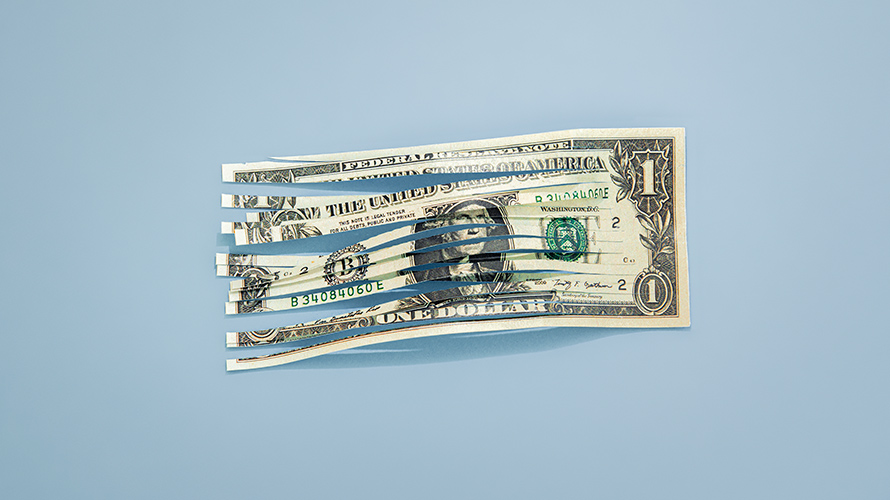
The Covid-19 pandemic will continue to negatively affect the advertising and media industries through the end of this year as consumption habits and marketing budgets change, but the ad market is expected to recover in 2021.
The revised economic fallout from the coronavirus was outlined in the latest ad forecast released today from Magna Global, the media strategy arm of IPG Mediabrands.
Overall, the company predicted “more subdued economic growth and advertising spend” than previously forecast for 2022 to 2024, said Magna evp of global market research Vincent Letang, who authored the report.
In the short term, total media owner ad revenues in the U.S. (among linear and digital properties) are forecast to decrease to $213 billion in 2020 from $224 billion in 2019.
The broader U.S ad market is only expected to decrease by 4% as political ad sales (projected to be $5 billion) and digital media help mitigate the decline forecast for linear sales (expected to decrease by 17%, excluding political ads).
While consumption on linear TV initially saw a surge as stay-at-home orders went into place mid-March, viewing leveled out in April.
In contrast, digital ads benefited from the increase in screen time, and ad spends in this sector (including search, video and social) will stabilize this summer and recover in the second half, according to the forecast.
Overall, digital advertising is now projected to grow 2% year-over-year, but digital video is expected to grow 10% and social will grow 7%.
That’s good news, especially for publishers, who could benefit from the changing trends in advertising. Already this year, most publishers reported downward trends in digital advertising, in part due to brand safety concerns over messaging appearing next to Covid-19 coverage.
Before this recovery, though, Magna is expecting “precipitous” declines in the second quarter, especially among local TV (30%), radio (34%) and print (40%).
“Beyond the short-term V-shaped recession/recovery impact on the economy and the advertising market, the Covid crisis will have global and long-term effects on society, business models, consumption habits, mobility and media usage,” Letang said.
Overall, the ad market in the U.S. is projected to stabilize in the third quarter and recover in the fourth quarter. If so, that’s a win for media organizations that were able to offer pay cuts and make other temporary changes to avoid layoffs, betting that the market would come back with a roar by the end of the year.
The U.S. ad market is now expected to rebound in 2021, with a 4% gain.
Magna had previously predicted the global ad market would grow to $745 billion by 2021. It’s now forecasting that it will only reach $647 billion by then.